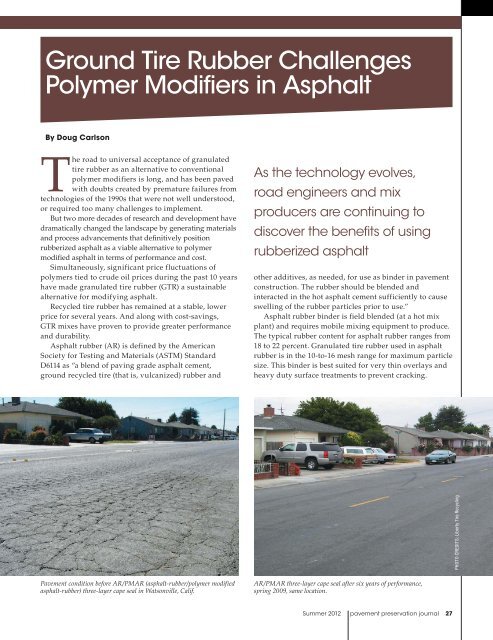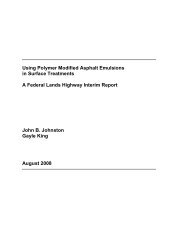journal - TSP2
journal - TSP2
journal - TSP2
Create successful ePaper yourself
Turn your PDF publications into a flip-book with our unique Google optimized e-Paper software.
Ground Tire Rubber Challenges<br />
Polymer Modifiers in Asphalt<br />
By Doug Carlson<br />
The road to universal acceptance of granulated<br />
tire rubber as an alternative to conventional<br />
polymer modifiers is long, and has been paved<br />
with doubts created by premature failures from<br />
technologies of the 1990s that were not well understood,<br />
or required too many challenges to implement.<br />
But two more decades of research and development have<br />
dramatically changed the landscape by generating materials<br />
and process advancements that definitively position<br />
rubberized asphalt as a viable alternative to polymer<br />
modified asphalt in terms of performance and cost.<br />
Simultaneously, significant price fluctuations of<br />
polymers tied to crude oil prices during the past 10 years<br />
have made granulated tire rubber (GTR) a sustainable<br />
alternative for modifying asphalt.<br />
Recycled tire rubber has remained at a stable, lower<br />
price for several years. And along with cost-savings,<br />
GTR mixes have proven to provide greater performance<br />
and durability.<br />
Asphalt rubber (AR) is defined by the American<br />
Society for Testing and Materials (ASTM) Standard<br />
D6114 as “a blend of paving grade asphalt cement,<br />
ground recycled tire (that is, vulcanized) rubber and<br />
As the technology evolves,<br />
road engineers and mix<br />
producers are continuing to<br />
discover the benefits of using<br />
rubberized asphalt<br />
other additives, as needed, for use as binder in pavement<br />
construction. The rubber should be blended and<br />
interacted in the hot asphalt cement sufficiently to cause<br />
swelling of the rubber particles prior to use.”<br />
Asphalt rubber binder is field blended (at a hot mix<br />
plant) and requires mobile mixing equipment to produce.<br />
The typical rubber content for asphalt rubber ranges from<br />
18 to 22 percent. Granulated tire rubber used in asphalt<br />
rubber is in the 10-to-16 mesh range for maximum particle<br />
size. This binder is best suited for very thin overlays and<br />
heavy duty surface treatments to prevent cracking.<br />
PHOTO CREDITS: Liberty Tire Recycling<br />
Pavement condition before AR/PMAR (asphalt-rubber/polymer modified<br />
asphalt-rubber) three-layer cape seal in Watsonville, Calif.<br />
AR/PMAR three-layer cape seal after six years of performance,<br />
spring 2009, same location.<br />
Summer 2012 pavement preservation <strong>journal</strong> 27
















